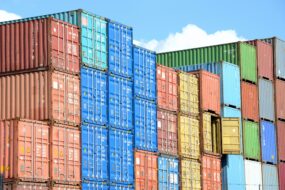Contents

Freight and cargo shipping involve moving large amounts of goods through trains, trucks, vans, ships, and planes, often in a more affordable and reliable manner. The cargo shipping market is expected to top 13 billion tons by 2028, growing at steady rates due to reduced shipping costs and efficient transportation methods.
There are multiple different types of freight shipping, which can offer your e-commerce business a safe, reliable, secure, and cost-effective method of shipping goods in bulk.
What Is Freight Shipping?
Large shipments of goods that are transported via air, land, or sea domestically or internationally classify as freight shipping. Often, freight shipping uses a variety of transportation methods, which can include the following:
- Trains
- Vans
- Trucks
- Ships
- Airplanes
Items shipped in bulk are loaded into large, sturdy containers or onto pallets to be shipped as freight.
When Packages Are Considered Freight
Shipments that are over 150 pounds or bigger than 30 inches by 30 inches by 30 inches are considered freight. Packages that are under these dimensions are more commonly sent as parcels.
A standard pallet size in the United States is 48 inches by 40 inches. Generally, a standard truck can fit up to 26 pallets.
Inventory that is loaded into a truck via a pallet can be easily unloaded using a forklift or a dock. Warehouses regularly have an elevated dock and/or the use of forklifts to unload pallets from trucks. Freight can also be floor-loaded into trucks and then manually offloaded.
Freight Shipping Methods Explained
There are five main types of freight shipping methods:
- Full truckload (FTL)
- Partial truckload (PTL)
- Less-than truckload (LTT)
- Intermodal
- Expedited
FTL (Full Truckload)
When shipping freight, you can fill an entire container to transport your inventory. A full container can usually hold between 24 and 26 pallets, and they can be moved via the road or by rail. FTL shipments are sent directly from the pickup location (such as the manufacturer) to the destination (like a fulfillment center).
PTL (Partial Truckload)
A PTL shipping is generally between 6 and 12 pallets. They will typically be kept on a single truck throughout the shipping process.
LTL (Less-Than Truckload)
One of the most commonly used freight shipping methods, LTL shipments are usually between one and six pallets. With LTL shipments, the freight is often moved between different trucks throughout the journey.
Intermodal
With intermodal shipping, different methods of moving the freight are used. This can include rail and truck, or a combination of rail, ship, and trucks. Using rail during the freight shipping process can help to save money on fuel costs.
Expedited
The most expensive method of shipping freight, expedited shipping generally involves a combination of truck and air. This type of freight shipping is usually only used for time-sensitive shipments.
Preparing a Freight Shipment
Freight shipments need to be prepared differently than typical parcel shipments. You will need to take steps to ensure that the goods are shipped, handled, and received as accurately and securely as possible.
Taking the following steps can help ensure that your shipment remains safe and secure:
- Prepare high-quality and appropriately sized pallets. When using a pallet, it should be made of wood or plastic, be sturdy enough to support your load, and be large enough to contain it.
- Prepare appropriate shipping containers. If you are not using a pallet for your freight, then prepare appropriately sized and sturdy shipping containers, corrugated boxes, or crates. Be sure to use dunnage on all sides of the container to secure your items and reinforce the edges. Seal all seams and openings with reinforced tape.
- Try not to reuse shipping boxes. If you must reuse, be sure that they are not compromised and that all old shipping labels are removed.
- Attach shipping labels. The label needs to be visible and contain the shipper’s address and telephone number on each side of the pallet.
- Follow all freight carrier instructions. Each carrier will have their own way of managing freight shipments, some of which even require pre-authorization, so be sure to check with them to see what they are.
How to Estimate Freight Shipping Costs
There are several factors to consider when estimating freight shipping costs, which include the following:
- Size and weight: The bigger and heavier your shipment is, the more expensive it is going to be to ship.
- Origin and destination: The farther your package has to travel between pickup and delivery, the higher the shipping rates will be.
- Mode of transportation: Rail or road shipping is going to be less expensive than shipping via air, for example.
- Special handling considerations: If your shipment needs temperature control or contains hazardous materials, you will incur additional shipping charges.
Benefits of Freight Shipping
There are numerous benefits when it comes to shipping bulk items via freight, including lower costs and more reliable and secure shipping methods.
More Cost-Effective
Freight shipping can offer lower costs and more cost-effective methods for shipping goods in bulk. It is commonly used to order goods from a supplier or manufacturer for your e-commerce business. Especially when using PTL or LTL freight shipping methods, you will only pay for the space your pallets/containers take up and can therefore split the truck shipping costs with other shippers.
Reliable Carriers
Using a quality freight shipper can ensure that your products are delivered on time, safely, and without worry. There are a variety of freight shipping experts to choose from, including FedEx Freight, UPS Freight, and DHL Freight.
Safer Shipping
Shipping your goods on a pallet can be safer than shipping them as parcels. The risk for theft and damage are much lower. You will also have the ability to track your goods in real time at every step along the way from pickup through to delivery.
Freight Shipping FAQs
What can be shipped as freight?
Most things can be sent as freight. However, it will be important to check with your carrier if you are shipping expensive items, hazardous items, or items that require temperature control.
What is a bill of lading?
Issued by the carrier, a bill of lading acknowledges the receipt of cargo for shipping. Generally, a bill of lading includes the destination of the goods, the type, and the quantity.
What is freight classification?
Freight class is determined by value, liability, density, weight, height, length, and ease of handling. It ranges from 50 to 500. The lower the number, the lower the cost. Freight classification is a standardization used by freight carriers for pricing.
What is the difference between parcel and freight?
A parcel is a smaller individualized package that is sent through traditional carriers, while freight is shipped in bulk for heavier items. Typically, parcels cannot exceed 150 pounds. Anything over that will be classified as freight.
How are freight shipping costs calculated?
Freight shipping costs will depend on weight, dimensions, mode of transportation, freight class, how far it has to travel, packaging type, and how fast it needs to arrive.
How can a 3PL help with freight shipping?
A third-party logistics (3PL) provider can handle all your shipping and order fulfillment needs. Freight shipping can be used to ship goods to a 3PL fulfillment center. The 3PL can set up freight shipments, receive the freight, unpack and store the inventory, and then work to efficiently and effectively fulfill customer orders.
References
Cargo Shipping Market Size to Hit 13.19 Billion Tons by 2028. (March 2022). GlobeNewswire.
FedEx LTL Freight Shipping Options. (2022). FedEx.
Schedule a Freight Pickup. (2022). United Parcel Service of America, Inc.
DHL Freight. (2022). DHL.




